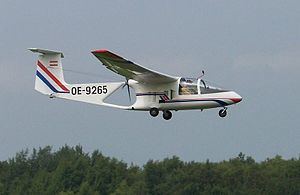Top speed 180 km/h Length 8 m | Wingspan 16 m First flight June 23, 1971 | |
 | ||
The Brditschka HB-3, HB-21 and HB-23 are a family of motor gliders of unorthodox configuration developed in Austria in the early 1970s.
Contents
Design and development
The unusual design was based on work done by Fritz Raab in Germany in the 1960s. The pilot and passengers sit in a fuselage pod with the engine and propeller behind them. The pod also carries the fixed tricycle undercarriage and the high cantilever wing. The tail is carried on a pair of booms that emerge from the top and bottom of the fuselage pod, the upper of which passes through the propeller hub. The HB-21 has a conventional tail and has two seats in tandem accessed by a sidewards-hinged canopy, while the HB-23 has a T-tail and side-by-side seating accessed via gull-wing doors in the canopy.
The Militky MB-E1 was a modified HB-3 with an 8-10 kW (11-13 hp) Bosch KM77 electric motor. It was the first full-sized, manned aircraft to be solely electrically powered. Flights of 12 minutes duration at up to an altitude of 380 m (1,247 ft) were just within the Ni-Cd battery's capacity. Its first flight was on 23 October 1973.
Variants
Specifications (HB-23/2400 Hobbyliner)
Data from Jane's All The World's Aircraft 1990
General characteristics
Performance
